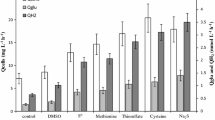Abstract
Acidaminococcus fermentans is able to ferment glutamate to ammonia, CO2, acetate, butyrate, and H2. The molecular hydrogen (approximately 10 kPa; E′ = –385 mV) stems from NADH generated in the 3-hydroxybutyryl-CoA dehydrogenase reaction (E°′ = –240 mV) of the hydroxyglutarate pathway. In contrast to growing cells, which require at least 5 mM Na+, a Na+-dependence of the H2-formation was observed with washed cells. Whereas the optimal glutamate fermentation rate was achieved already at 1 mM Na+, H2 formation commenced only at > 10 mM Na+ and reached maximum rates at 100 mM Na+. The acetate/butyrate ratio thereby increased from 2.0 at 1 mM Na+ to 3.0 at 100 mM Na+. A hydrogenase and an NADH dehydrogenase, both of which were detected in membrane fractions, are components of a model in which electrons, generated by NADH oxidation inside of the cytoplasmic membrane, reduce protons outside of the cytoplasmic membrane. The entire process can be driven by decarboxylation of glutaconyl-CoA, which consumes the protons released by NADH oxidation inside the cell. Hydrogen production commences exactly at those Na+ concentrations at which the electrogenic H+/Na+-antiporter glutaconyl-CoA decarboxylase is converted into a Na+/Na+ exchanger.
Similar content being viewed by others
Author information
Authors and Affiliations
Additional information
Received: 3 May 1996 / Accepted: 12 August 1996
Rights and permissions
About this article
Cite this article
Härtel, U., Buckel, W. Sodium ion-dependent hydrogen production in Acidaminococcus fermentans. Arch Microbiol 166, 350–356 (1996). https://doi.org/10.1007/s002030050394
Issue Date:
DOI: https://doi.org/10.1007/s002030050394




